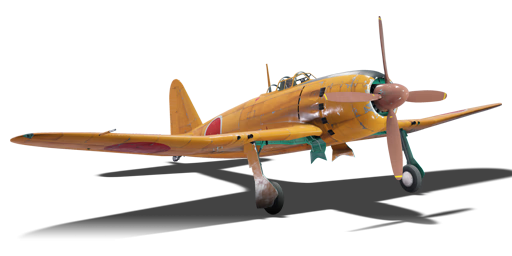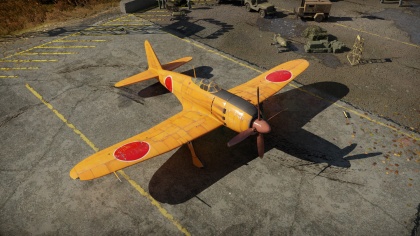A7M1 (NK9H)
Contents
| This page is about the Japanese premium fighter A7M1 (NK9H). For the regular version, see A7M2. |
Description
The A7M1 Reppu (NK9H) is a premium rank IV Japanese fighter
with a battle rating of 5.0 (AB/RB) and 4.7 (SB). It was introduced in Update 1.53 "Firestorm".
The A7M1 Reppu is the prototype version of the A7M2 in the tech tree fitted with a NK9H engine. In game this fighter is a jack of all trades - excellent energy retention, amazing turn rate, and acceptable speed. These traits make the Reppu an excellent weapon for players who enjoy being the tip of the spear.
General info
Flight Performance
| Characteristics | Max Speed (km/h at 6,900 m) |
Max altitude (meters) |
Turn time (seconds) |
Rate of climb (meters/second) |
Take-off run (meters) | |||
|---|---|---|---|---|---|---|---|---|
| AB | RB | AB | RB | AB | RB | |||
| Stock | 594 | 578 | 11000 | 15.7 | 16.2 | 13.6 | 13.6 | 250 |
| Upgraded | 639 | 617 | 14.8 | 15.0 | 21 | 16.9 | ||
Details
| Features | ||||
|---|---|---|---|---|
| Combat flaps | Take-off flaps | Landing flaps | Air brakes | Arrestor gear |
| ✓ | ✓ | ✓ | X | ✓ |
| Limits | ||||
|---|---|---|---|---|
| Wing-break speed (km/h) |
Gear limit (km/h) |
Combat flaps (km/h) |
Max Static G | |
| + | - | |||
| 826 | 310 | 510 | ~12 | ~10 |
| Optimal velocities | |||
|---|---|---|---|
| Ailerons (km/h) |
Rudder (km/h) |
Elevators (km/h) |
Radiator (km/h) |
| < 400 | < 380 | < 380 | > 317 |
| Compressor (RB/SB) | ||
|---|---|---|
| Setting 1 | ||
| Optimal altitude | 100% Engine power | WEP Engine power |
| 2,000 m | 1,875 hp | 2,089 hp |
| Setting 2 | ||
| Optimal altitude | 100% Engine power | WEP Engine power |
| 6,000 m | 1,675 hp | 1,866 hp |
Survivability and armour
- 13 mm steel plate behind seat, tilted 13°
- 70 mm bulletproof glass forward of seat, tilted 24°
- Self-sealing fuel tanks
Armaments
Offensive armament
The A7M1 (NK9H) is armed with:
- 2 x 20 mm Type 99 Model 2 navy cannons, wing-mounted (200 rpg = 400 total)
- 2 x 13.2 mm Type 3 navy machine guns, wing-mounted (300 rpg = 600 total)
Suspended armament
The A7M1 (NK9H) can be outfitted with the following ordnance:
- Without load
- 2 x 60 kg Navy Type 97 Number 6 bombs (120 kg total)
Usage in battles
The A7M1 is a relatively heavy plane but still as agile as an A6M5, thus, making it a "multi task" aircraft when it comes to air battles as in ground battles it is obsolete as it only carries anti infantry bombs which do little to no damage to the vehicles at its br. The A7M1 can be used as an energy fighter and a turn fighter, although it is sometimes tricky to be energy fighter to enemies like F6F-5, P-51, etc.
Low altitude fighting:
This is where the A7M1 exceeds the most, only couple planes like spitfires can be a challening oponent at low altitudes, mainly because most planes will loose energy when fighting with you at low altitudes when you are able to outturn and be on their tail in couple seconds. The 13mm and 20mm machine guns are enough to tear down a plane in couple bursts. Aim for center of mass when turn fighting, for tail when tailing, specially elevators.
High altitude fighting:
Turn fighting at high altitude is rather dificult since, the higher you go, the less air pressure there is. Meaning there will be less air to lift your plane when doing a hard turn compared to sea level, meaning you will not be able to turn as fast as you do at sea level. This should be taken into consideration since most of the planes at high altitudes (4km+) often have superchargers or turbochargers (Wyvern for example) and will make out of you an easy prey as you do not maintain the same energy they maintain nor speed. But, this does not stop the A7M1 of fighting in the clouds, one of the easiest targets for the A7M1 are bombers. They are big, have big wingspans and are often slow (unless they are dive bombers or strike fighters). They can be easily killed with the 20mm cannons due to their high rate of fire and destructive ammunition. When engaging a bomber, aim for the engines or wings. This will disable the plane, reduce their speed, reduce their max flying range and often will make them start to loose altitude; lit them on fire, make oil leaks, fuel leaks or completely tear apart the wing. Be smart when engaging a bomber, attack them from their weakspots (often the belly or in a headon) and do not rush, your plane will not stand more than 5 seconds in enemy fire as your plane will lit on fire pretty often and burn really quick.
A7M1 MUST DO:
Keep the most energy you can, be precise with your shots as ammunition is not numerous.
A7M1 NOT TO DO:
When fighting enemy bombers, DO NOT tail them. The A7M1 will lit on fire and it will be really hard to stop the fire, it will burn to death before stopping the fire.
Manual Engine Control
| MEC elements | ||||||
|---|---|---|---|---|---|---|
| Mixer | Pitch | Radiator | Supercharger | Turbocharger | ||
| Oil | Water | Type | ||||
| Controllable | Controllable Not auto controlled |
Controllable Not auto controlled |
Controllable Not auto controlled |
Separate | Controllable 2 gears |
Not controllable |
Modules
| Tier | Flight performance | Survivability | Weaponry | ||
|---|---|---|---|---|---|
| I | Fuselage repair | Radiator | Offensive 13 mm | ||
| II | Compressor | Airframe | New 13 mm MGs | 9 in (mod30) | |
| III | Wings repair | Engine | Offensive 20 mm | ||
| IV | Engine injection | Cover | New 20 mm cannons | ||
| This is a premium vehicle: all modifications are unlocked on purchase | |||||
Pros and cons
Pros:
- Excellent energy retention
- Exceptional maneuverability below 500km/h IAS
- Great armaments
Cons:
- Engine tends to overheat
- Slow compared to allied fighters
- Elevator lock up above 500+ km/h IAS
- Slow roll rate
- Cannons have low rate of fire
History
In late 1940, Just after the A6M started entering its production phase, the navy requested Mitsubishi to start development of a direct successor by 1941, but due engine choice for a high-output compact engine was scarce, and the development team having their hands filled with development of the A6M2 Mod.21 and developing the J2M made Mitsubishi decide to scrap the request.
By 1942 as development of the A6M3 Mod.32 and J2M2 Mod.11 have been finished, the navy once more ordered Mitsubishi and their team to design a direct successor which would be faster and as nimble as the Zero, but as before, engines which would suit the plane were still in development and the team had to design a plane while still having to wait on a viable engine.
As development of the A7M platform came to an end, the last set piece and main problem of the A7M development, being the engine led to the first prototype to make use of the Nakajima NK9 "Homare". This singular plane would be the first A7M and respectively would become the A7M1 and a trial flight would be performed on the 6th of May, 1944.
While the wingload was acceptable of 150 kg/m², maneuverability and handling were excellent but the engine was simply underpowered and couldn't meet the speed requirements the Navy were looking for and ended up in a disappointed cancel of the project.
But as Mitsubishi already got a greenlight to use Mitsubishi's home-made engine with the MK9 beforehand, the project sparked interest once more for the Navy with the A7M2.
Media
Excellent additions to the article would be video guides, screenshots from the game, and photos.
See also
Links to the articles on the War Thunder Wiki that you think will be useful for the reader, for example:
- reference to the series of the aircraft;
- links to approximate analogues of other nations and research trees.
External links
Paste links to sources and external resources, such as:
- topic on the official game forum;
- encyclopedia page on the aircraft;
- other literature.
| Mitsubishi Company (三菱商会) | |
|---|---|
| Fighters | A5M4 · Hagiri's A5M4 |
| A6M2 mod. 11 · A6M2 · A6M3 · A6M3 mod. 22 · A6M3 mod. 22Ko · A6M5 · A6M5 Ko · A6M5 otsu · A6M5 Hei · A6M6c | |
| A7M1 (NK9H) · A7M2 | |
| J2M2 · J2M3 · J2M4 Kai · J2M5 · J2M5 (30 mm) | |
| Hydroplanes | F1M2 |
| Interceptors | Ki-83 · Ki-109 |
| Bombers | G4M1 |
| Ki-21-Ia · Ki-21-I hei · Ki-67-I Ko · Ki-67-I otsu | |
| Jet Fighters | Ki-200 |
| Captured | ▃A6M2 · ␗A6M2 |
| See also | Mitsubishi Heavy Industries, Ltd. (Post-War) |
| Japan fighters | |
|---|---|
| Navy | |
| Carrier-based fighter | |
| A5M | A5M4 · Hagiri's A5M4 |
| A6M | A6M2 mod. 11 · A6M2 · A6M3 · A6M3 mod. 22 · A6M3 mod. 22Ko · A6M5 · A6M5 Ko · A6M5 otsu · A6M5 Hei · A6M6c |
| A7He | A7He1* |
| A7M | A7M1 (NK9H) · A7M2 |
| Land-based Fighter | |
| J2M | J2M2 · J2M3 · J2M4 Kai · J2M5 · J2M5 (30 mm) |
| J6K | J6K1 |
| J7W | J7W1 |
| N1K-J | N1K1-Ja · N1K2-J · N1K2-Ja |
| Fighter seaplane | |
| N1K | N1K1 |
| A6M-N | A6M2-N |
| Army | |
| Ki-10 | Ki-10-I · Ki-10-I C · Ki-10-II · Ki-10-II C |
| Ki-27 | Ki-27 otsu · Ki-27 otsu Tachiarai |
| Ki-43 | Ki-43-I · Ki-43-II · Ki-43-III otsu |
| Ki-44 | Ki-44-I · Ki-44-I 34 · Ki-44-II otsu · Ki-44-II hei |
| Ki-61 | Ki-61-I ko · Ki-61-I otsu · Ki-61-I hei · Tada's Ki-61-I hei · Ki-61-I tei · Ki-61-II Otsu Kai |
| Ki-84 | Ki-84 ko · Ki-84 otsu · Ki-84 hei |
| Ki-87 | Ki-87 |
| Ki-94 | Ki-94-II |
| Ki-100 | Ki-100 · Ki-100-II |
| Other countries | ▅F4U-1A · ▅P-51C-11-NT · ▅Bf 109 E-7 · ▅Fw 190 A-5 |
| *Imported designation of the He 112 (A6M was in development - A7M would take A7 designation after the cancelation of the A7He) | |
| Japan premium aircraft | |
|---|---|
| Fighters | Hagiri's A5M4 · A7He1 · Ki-27 otsu Tachiarai |
| Ki-44-II otsu · ▅Bf 109 E-7 · ▅F4U-1A · Ki-100-II · Ki-44-I 34 | |
| ▅Fw 190 A-5 · A7M1 (NK9H) · Tada's Ki-61-I hei · ▅P-51C-11-NT | |
| J2M4 Kai · A6M5 Ko · A6M6c · J2M5 · Ki-87 · J6K1 | |
| Twin-engine fighters | Ki-96 |
| Jet fighters | F-86F-40 JASDF▅ · T-2 Early · F-4EJ ADTW |
| Strike aircraft | ▄AV-8S |
| Bombers | Ki-21-I hei · Ki-48-II otsu · H8K3 · B7A2 (Homare 23) · ▅B-17E |





